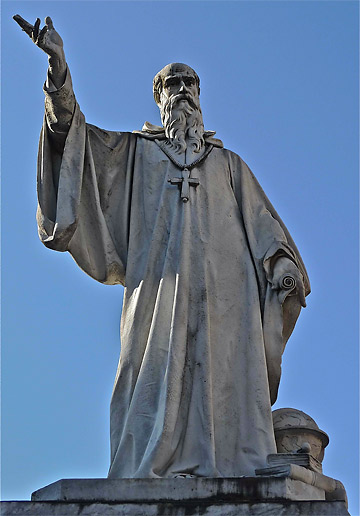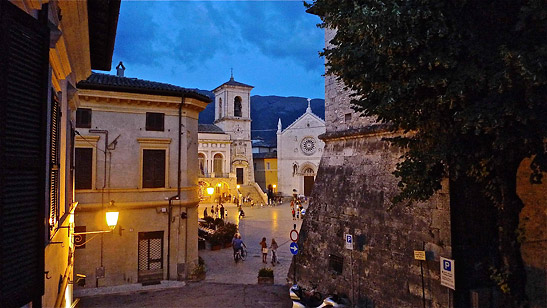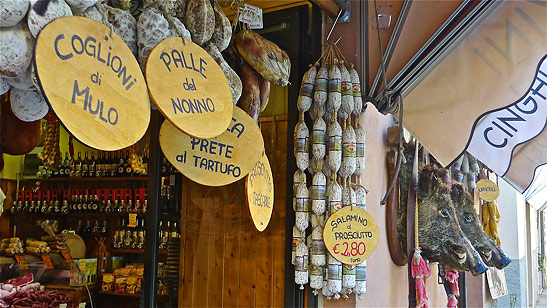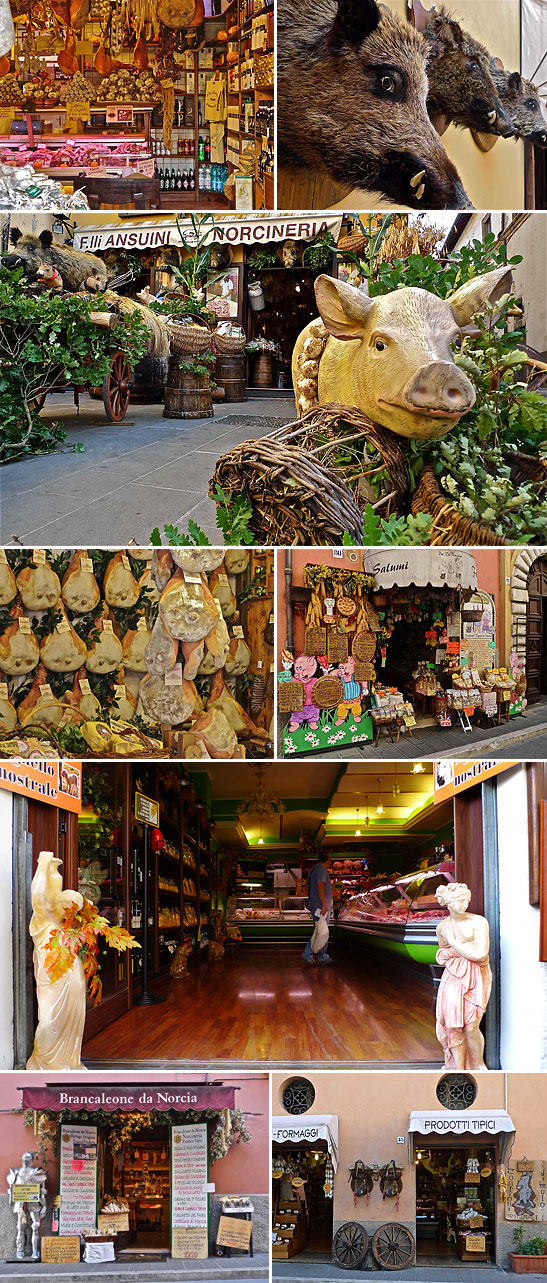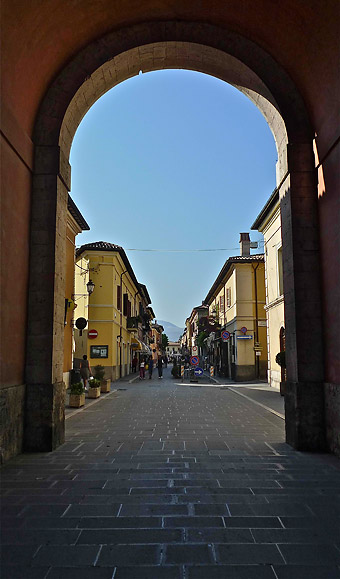 |
 |
|
 |

|
Saints and Truffles And Wild Boar, Oh My! Story and photos by Tom Weber
My Grandfather's What? Less divine, but equally renowned, are the world-famous DOP (Denominazione di Origine Protetta - Protected Designation of Origin) agricultural products from the area found inside butcher shops/delicatessens located on just about every street corner: rare and expensive ($1,500 per kilo) black truffles, delectable pork and wild boar salamis and sausages with colorful, or off-color, names like coglioni di mulo (mule testicles) and palle del nonno (grandfather's balls), mutton that share their destiny with Cleopatra's eunuchs called castrato (castrated), the benchmark high-plains lenticchie (lentils), and plenty of pecorino (sheep) cheeses to suit just about everyone's palette.
Norcia - Three Millennium and Counting An ornate and charming retreat in the high country of Umbria that has a history spanning more than 3,000 years, Norcia is famous today for its array of pork products, and its savory cuisine highlighted by the black truffle.
Noted for its nearby hunting preserves, especially wild boar, people come to Norcia to experience an intact, low-rise medieval walled city, but stay for the pork. Because of the - pardon the pun - "link" between the city and its pork products, swine-only butcher shops are uniquely called norcinerie vice macellerie around the rest of the country. You cannot walk down a street or alleyway in Norcia without passing by a norcineria or two, or three.
Enjoy the Pork and the Sights, Too Pork aside, Norcia is well worth the visit. Its mountain air and relatively broad main streets and quaint flowered alleyways make for a pleasurable stroll through medieval times. Surrounded by the Sybilline mountain range, this village sits flat, unusual among the towns of Umbria. It's enclosed by a full circuit wall with tall arched gates that have survived since the 14th century AD, which makes Norcia an easy and relaxing town to go on foot to see the main sights. The Pulse of the Village Join your fellow travelers in Piazza San Benedetto (St. Benedict's Square), the town's circular main square. There, all in one place, you'll find the Palazzo Comunale (City Hall Palace), the Basilica of St. Benedict, the arched Portico of Measurements or Merchants Loggia, the Cathedral of St. Mary Argentea, and La Castellina (the Papacy Fortress built by Pope Julius III, which now houses the Civic Museum). Within strolling distance of the main square are the Teatro Civico (Civic Theatre), the World War I monument and the Porta Romana (Roman Gate).
And, of course, never far from sight, no matter where you are in the village, are the countless norcinerie where a part of someone's grandfather's anatomy hangs in full view for all to see. For detailed tourist information in English on everything Norcia, visit the Bella Umbria website: www.bellaumbria.net/en/. Related Articles: |
|
Feedback for Destination Bosnia: Inside Sarajevo's Tunnel of Hope Spent time in Sarajevo in the fall of 1973…beer was excellent! --- David * * * * Hi Tom, I must say, you're photographs are always amazing. They are top notch. You bring so much class to Traveling Boy. It's photographs like yours that make me want to go out and do my own traveling. Please don't get tired of sending us your amazing adventures. It's such a delight for the soul. --- Raoul, Whittier, CA * * * * Hi Tom: --- David * * * * Hey Tom – Wow! Love those photos – they are so super that they make me A) Want to start eating NOW. B) Go there myself. C) See all that pristine beauty that looks so restful and peaceful. Great story, superb pix!!! Bravo!! --- John, Los Angeles, CA * * * * Feedback for Destination Southwestern France: Saint-Émilion Good job, Tom, and timely info. St. Émilion is in the list of places Jim Hayes and I will visit in September 2014. If we get the chance, we will exploit your experience to enhance the trip! --- Bobby Harper, Dameron, MD * * * * Feedback for Vicenza Walks – Monte Berico I lived in Vicenza for 4 years in the U.S. ARMY from 1963 to 1967. A wonderful place to explore. Palladio’s works are amazing. Have been back twice since and find new places to visit. My favorite is MONTE BERICO where I have some wonderful photos of my family. --- Dr. Albert Pizzi, Hanover, MA * * * * I liked the new TB particularly the Vicenza article that took me back as a youth when we lived in Naples and travelled up there for a baseball tourney (U.S. Military Bases dependent schools played each other.) Took me back to the plaza. --- Bill Feedback for A Canterbury Trail (Sutri) Very interesting note. I have wedroned which route the early pre-Christian and Christian pilgrims travelled to Rome from England. Is it still possible to travel the Francigena trail? --- Pawel You can find out more info on walking tours of Via Francigena at this site: http://www.compagniadeicammini.it/en/. Thanks for stopping by and commenting.. Tom * * * * Good article, enjoyed reading it. Saved your recommended sights for future use. --- Dardenne Prairie, MO * * * * You're going to be great at this Tom. Congrats. --- Donna Vissa -Montreal
|
This site is designed and maintained by WYNK Marketing. Send all technical issues to: support@wynkmarketing.com

|






 ith
everyone, and I mean everyone, getting out of Dodge for Ferragosto
(the Festivals of August and Feast of the Assumption) I finally
relented and joined the nationwide exodus. Destination? Umbria,
the "land of saints," specifically Norcia in central
Italy.
ith
everyone, and I mean everyone, getting out of Dodge for Ferragosto
(the Festivals of August and Feast of the Assumption) I finally
relented and joined the nationwide exodus. Destination? Umbria,
the "land of saints," specifically Norcia in central
Italy.